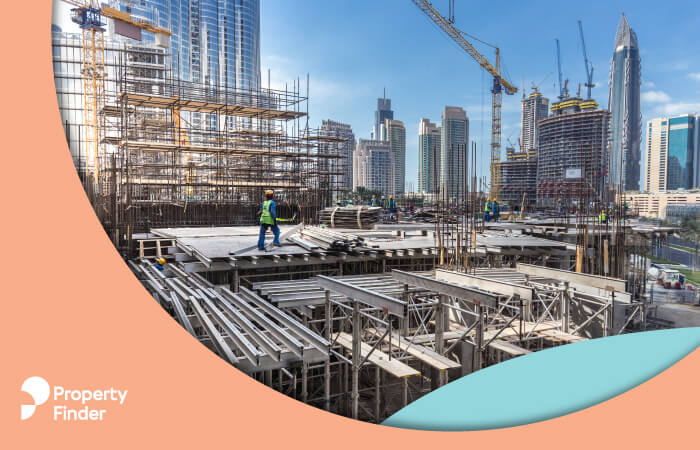The traditional laws of supply and demand will say that as demand increases, supply should increase alongside. Consequentially, when demand decreases, supply should also trend downward.
In Dubai, those watching the real estate market and applying this logic, are waiting for the other shoe to drop. The many successes Dubai has achieved, from architectural feats to a regulatory environment where businesses can flourish in the region, has drawn human capital from around the world. With an exponentially growing population, an increased housing supply was certainly in order. Given that the United Nations Population Division projects that the United Arab Emirates population will grow between five to six percent per annum up through 2050, that may still be the case today.
Dubai supply from 2016 to 2017
As of 2016, residential supply added to Dubai’s market consisted of 8,750 apartments and 5,000 villas and townhouses according to a year-end report from Asteco, for a total of 13,750 units. In 2017, 13,900 apartments were added in addition to 3,600 villas and townhouses, for a total of 17,500 units. Per our calculations in-house, overall, there was a 21 percent increase in the number of units from 2016 to 2017 and a 37 percent increase in the number of apartments in 2017 as compared to 2016. Similarly, there was a 28 percent decrease in the number of villas and townhouses in 2017, compared to 2016. As of year-end in 2017, some outlets were projecting to see 23,000 apartments and 8,500 villas and townhouses added in 2018, with the expectation that property prices would decline further due to the sheer amount of supply expected to be added to the market.
Completion rates to double in 2018
As of October 2018, research done in-house at Property Finder has accounted for 19,881 units to be completed for 2018. Additional research shows that through ongoing projects with a completion status of at least 95 percent, 14,707 more units could also be expected by the end of this year, per project updates from Dubai Land Department (DLD) and its affiliates.
Further analysis of those statistics finds that of the 14,707 additional units to be completed by year end, 13,660 of those units are apartments and the remaining 1,047 are villas or townhouses. Considering the advanced completion stage of these 14,707 units, those being added to already completed supply for 2018 could potentially result in the addition of an astounding 34,588 new units in total for 2018. Accounting for already existing supply, there were 489,000 units in Dubai at the end of 2017, 403,000 of which are apartments and 86,000 of which are villas or townhouses.
It is important to keep in mind that there’s a difference between a project reaching completion status, and subsequently being handed over to its owner. Sometimes handovers can take several months or much longer. Considering this, it is fair to say that not all of these units will be available to home buyers by the end of the year” according to Lynnette Abad, Director Research & Data Property Finder Group.
Where is demand coming from?
The other side of this story is the demand. We have to ask where the demand is coming from to account for this increase in supply. The Dubai Statistics Center publishes annual estimates for the emirate’s population, which estimated Dubai’s population to be 2,976,455 people in 2017; an increase of about 6.7 percent from the previous year’s estimate.
Although there are no occupancy rate statistics to consult, DEWA’s 2017 Annual Report notes that there were nearly 594,000 customers who requested water and electricity in total. According to the Dubai Statistics Center, there are an average of 4.2 people per household, which would result in approximately 2.5 million residents using the Emirate’s water and electricity services. Furthermore, we can assume that 594,000 DEWA customers equates to about the same number of households, and therefore the same number of occupied units as of 2017.
While the statistics on exact population figures for Dubai are a mixed bag, we do have the aforementioned sources to consider. Based on these figures, and those from just a few years back, Dubai’s net population growth, which is births minus deaths plus net migration rates, appreciates between six to seven percent per annum. Considering an additional 175,000 net residents added approximately, and assuming the average of 4.2 people per household, that would mean we need an approximate 42,000 additional units per year. For the past three years, residential supply added to the market has been approximately three percent of already existing supply. If these 20,000+ units are added to the market in the next two months, that would be an increase of ten percent of already existing supply, more than three times the historical rate.
Historically, actual supply has not materialized to be more than 40-50 percent of projected supply. However, as we near Expo 2020, 2018 has taken a remarkable turn in completing and delivering new supply into the market and 2019 is expected to follow a similar trend” says Lynnette Abad, Director Research & Data for Property Finder Group.
Thus we have to ask, will demand outstrip supply or will supply meet demand?
_______
This article was co-written by Carla Maria Issa and Lynnette Abad from Property Finder.


